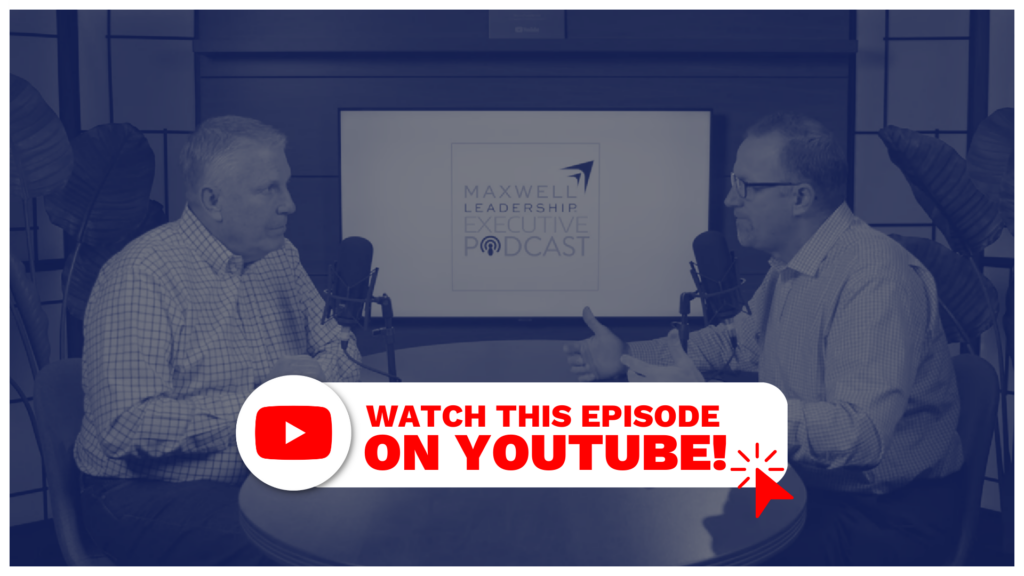Executive Podcast #234: The Power of Thinking for Leaders

This topic is referencing one of John Maxwell’s books, “Thinking for a Change.”
In the book, John emphasizes the power of intentional thinking in achieving personal and professional success. John says our thinking habits have a profound impact on our lives and that by changing our thinking, we can change our lives.
Download our Learning Guide for this podcast!
Perry Holley:
Welcome to the Maxwell Leadership Executive Podcast, where our goal is to help you increase your reputation as a leader, increase your ability to influence others, and increase your ability to fully engage your team to deliver remarkable results. Hi, I’m Perry Holley, a Maxwell Leadership facilitator and coach.
Chris Goede:
And I’m Chris Goede, executive vice-president of Maxwell Leadership. Welcome, and thank you for joining. If you’re interested in bringing some leadership development training, coaching, consulting, to your organization, love for you to visit maxwellleadership.com/podcast. Fill out a form there. We will reach out to you. We’ll talk a little bit about what the needs are. And you can also at that same place, you can download today’s learner guide with the lesson, or leave us a comment or a question. We’d love to hear from you there. Well, today’s topic is titled The Power of Thinking for Leaders.
We don’t think enough. And I’m going to be honest with you, as I was going through this lesson and preparing for our time, there’s no doubt, I was like, “I need to do a better job of this as a leader,” because I’ve become at times so reactive. And John has a book that is Thinking For a Change, and I’ve heard you talk about this book before, and how you’re like, “I’m not going to read that.”
Perry Holley:
I’m not reading that book.
Chris Goede:
And then all of a sudden, you picked it up and you were just like …
Perry Holley:
[inaudible 00:01:26] pick it up. I was struggling mightily in this part of my career, and I didn’t know what the strategy, I didn’t know what to do. I thought all these factors are hitting all these market changes, all these economic. And I thought … And then somebody said, “What’s your thinking process like?” I went, “What? Hadn’t thought about that.” I’m hair on fire all day every day. I don’t have time to think. But they said, “Well, you should look at this book,” and so I thought, “I swore I’d never read that book,” and here it is.
And it found me at a time when I absolutely had to have it. John just, as always, lays it out in such a way that says, “Wow, I need to spend some time,” any time would’ve been more time, so I need to spend some time thinking. And how do you do that? What is the process of being a good thinker? I’ll let you talk about some of John’s habit and how he does that. But I think for me it was a profound book to help get me moving in the right direction to dedicate some time to do that. And I think it’d be enjoyable to talk about with you, what those six types of thinking are.
Chris Goede:
I firmly believe this is something all of us can improve on. We’ve got to be intentional about it. We’ve got to develop habits around it. And even whether you carve out some time in your daily schedule, your weekly schedule, maybe it’s your quarterly schedule, to really spend some time thinking, it’s an absolute must for those of us that are, I would say leading, but I would even just say even as individual contributor or part of a team, of how you can add value to the team. And the only way to figure that out is to quit being in it and to be thinking on it, which we’ve talked about previously.
So let me share how John has taught this approach to thinking. The full title of the book is Thinking For a Change: The Power of Intentional Thinking. The intentional part is the difference maker. Right?
Perry Holley:
Right.
Chris Goede:
As you said, we may think and react. But are we really spending some intentional time to really, really think? And so John teaches that we should have a specific time of day for thinking, have a specific place for thinking, have a specific thing that we’re going to think about, which is key for me because I could see myself saying, “All right, here we go.” And then I would get there and I’d be thinking about sports statistics and life, and how I solve this problem. And I’m not necessarily focused and I’m wasting that time. Remove all distractions. Boy, when John wrote the book, I promise you this, there were not as many distractions in everybody’s life as there is today.
Perry Holley:
That’s true.
Chris Goede:
That could probably be the first one. And then John said, “Have a pad of paper and a pencil ready,” or your iPhone, or your iPad, not a four color pen like he still uses to this day to write his books. So many of you may say, “Okay, well, this is awesome. I’ve heard a lot about this before, but it is not for me.” And I would suggest, and I think Perry would agree, this is something that you can’t not do. Right? As leaders, you need to make sure that you do that. So let me encourage you, whether it’s 15, 20 minutes a day, again, back to a minute ago, whether it’s you carve out a whole day of a week or a month to really focus on this. This is something that will benefit you as a leader if you really dial in and become a focused thinker.
Perry Holley:
Yeah. I want to encourage you too, the way I started when I first thought about it was: How am I going to set aside an hour, or two hours, or whatever, to do this? It can be two to five minutes, 10 minutes to 15 minutes, just finding a place to have a quiet moment with an idea that you want to think on. It goes a long way. So don’t start by setting some big, hairy, audacious time limit. I would actually start with a minimum that you’ll do, but you’ll do it every day, and let it compound over time is how I got into this.
Chris Goede:
That’s good.
To be a Successful Leader, You Need Feedback on Your Leadership.
We’re excited to announce our new and improved Organizational Effectiveness Survey (OES). The OES gathers feedback from employees to give leaders and management the knowledge and action plans needed to develop a more effective and productive work environment. Our new version measures 4 areas of your business: Leadership, People, Strategy, and Performance.
Perry Holley:
So let me share the six, we’ll go through the six. I’d love to get your point of view on these. But number one that John talks about in the book is big picture thinking. And it involves looking beyond the obvious day to day, and really understanding the larger context of the situation you find yourself in. Look at the different factors and systems interconnected about how things are going on at work, and then developing this big picture thinking, and really help you to understand more complex problems. So if you’re trying to solve something that you want to have a more informed decision on it, you’re thinking about it, how things interconnect in your business, how your teams work across different customer sets.
I’m coaching one guy who, there’s a sales team, and there’s a technical, he has the tertiary, the third level sales support. They have a very odd role, but they’re very important. But he said, “I had to really [inaudible 00:06:28] sit down and think how to make this team really add value to the frontline sales support.” He goes, “It wasn’t very obvious. It was complex about how we all work together.” Oh, well, just think about it. How can we lay that out? So I love this idea, and John really … He has his thinking chair. Great, if you have that. I often just turn audio off in my car and have some time there, or spend some time going out on my back porch, and don’t take my phone. Take a walk to go get a coffee and don’t take my phone at the office. Just little things where I have time that my brain can engage without all the distraction.
Chris Goede:
You’ve heard it before, where people say, “Hey, start with the end in mind,” and think about the big picture, not only … I love Perry’s example about the team of the leader he’s coaching. Think big picture of: How can your leadership, your team, really impact and create opportunities, future opportunities, for the enterprise as a whole? So if I think about Maxwell Leadership, we have under our umbrella many different verticals of business units. And so how does our team play into that bigger role? What does that look like? How do I have a bigger picture of how we can impact and add value to different parts of the enterprise? And then dwindle it down to a way to where it resonates with those that are on your team, so they can see what they’re doing and how it impacts the bigger picture. I think that’s key. And the only way to do that is to really, to your point, shut the radio off, sit in the car. Ask yourself a question, and then think through it.
Perry Holley:
It leads to number two, which is focused thinking, that ability to concentrate, avoid those distractions, and really focus your thinking on one thing, one situation you’re trying to solve. It really is, this is my go to problem solving idea about thinking is, we’re facing something. I know we’re trying to produce some new content. I’m facing a certain issue, and I really didn’t know how to approach it. And I thought, “I need a focused time just to think.” What are the options? What could I possibly do? I might do some reading. I might listen to some things. I might get some input. But then I go away and just to a quiet place, either in my house, in the office, or in my car, and with a pad and pencil or a pen and think, “What are the option? What could I do?”
And I’m just telling you, when you put yourself in that position, you’d be amazed at what your brain will kick in based on the things that you’ve been noodling on. You can start to focus that in and get to a problem solving idea.
Chris Goede:
Yeah. I love your example. Let’s remove the distractions. Let’s make sure we’re not being reactive. And then let’s really get focused on it. And I would say you probably do this as a content writer and developer for us at Maxwell Leadership around all of our corporate content, even the podcast. You probably get away. We hear from a listener, they have a question. They have a theme. They say, “Hey, how would you handle this?” You might write that statement down, and then you get really focused, remove distractions, and go, “What is it that I know about this? What can I learn about this? What do I want to share about this?” Start asking questions. And you get really focused just around the power of thinking, for example, for this lesson. And then what ends up coming out of that is an incredible podcast lesson.
Perry Holley:
That leads to follow that example about creative thinking was number three John talks about in this kind of passageway to new ideas and new approaches to problems. It’s essential for any kind of innovation and growth that you may want to have to brainstorm. Many of us, we teach this about kind of abstract or concrete in your thinking. Concrete, I know what works and I kind of stick with that. Can I move to the abstract side and really think, “Well, what’s possible?” Kind of the outside the lines, outside the box type of thinking. And if I can develop this ability to think creatively, it really helps me to be more competitive, bring new ideas to bear.
You called me late yesterday and I said, “Hey, I got an idea. I’m thinking about this.” We have a member of our team and she’s got an idea a minute, but she’s got that creative thinking. It’s really her strong point. I think I’m more on the focused thinking. Maybe there’s-
Chris Goede:
Interesting.
Perry Holley:
One of them is one of your better ones. But I think we all need to have all of them, so it helps me when I talk to her. She gives me creative ideas. I go, “Oh, I need to think about that.” So then I’ll go do the focused thinking on somebody else’s creative idea. But it does require that I can’t just sit down and create. I need to think about it before I can put it on paper.
Chris Goede:
I would also encourage you that maybe if this is not a natural … I like what you said. That’s really good. Of the six, we probably have natural bends towards-
Perry Holley:
[inaudible 00:11:22].
Chris Goede:
Certain ones. But maybe this is one that is not a natural bent for you, I want to encourage you to put yourself in situations or environments, not a ton of distractions, but that get your creative juices flowing. Some of that may say, “Hey, I’m going to go for a hike, and I’m just going to find a place to sit down and be around nature. And I’m going to get creative.” Some of you may be putting yourself in a different environment. Mark Cole, our CEO, and I were talking just about a team that we have that’s thinking about the future of our business and what we’re doing. And one of the ideas I had was, hey, let’s quarterly be at an offsite location to maybe create some thoughts about our business that we normally wouldn’t be able to create or to think about unless we were surrounded by this environment.
Now again, don’t get distracted. There’s a balance there. But our brains are so complex, and we only tap into a small percentage of them, that I think if you would challenge yourself around this creative thinking, I even say, “Well, I’m not a very creative guy.” But when I get away and I get in certain situations, I look at that and I got, “How would that apply over to this situation?” All of a sudden, I go, “That was a pretty creative idea,” because creativity could also be taking two things and putting them together to create a new thing. And that’s creative, but it wouldn’t have happened if I wouldn’t have put myself in another creative environment.
Perry Holley:
I think most, well, all of us were born creative. I’ve never seen a two year old that wasn’t paint and make a picture on the refrigerator door.
Chris Goede:
That’s true.
Perry Holley:
But it takes a while for us to get fearful about trying new things. And so I think you’re right, if you say, “I’m going to actually dedicate some time to thinking outside the box,” what possible you can do that.
Maxwell Leadership Growth App:
Hey, podcast listeners, do you have a clear plan for growth? Achieving big results most often does not require big life changes. Small improvements over time compound into big results. Download the Maxwell Leadership App. It’s the new free app, where our expert guides and John Maxwell help you pace your leadership journey and set a clear plan for your own personal growth. You can also find all sorts of resources on the Maxwell Leadership App, including this podcast, information on upcoming events, and much more. Just search Maxwell Leadership in your app store and download the app today.
Perry Holley:
Number four, John talks about realistic thinking. And I love this about thinking through reality, not getting too exaggerated, letting biases distort, those types of things, but thinking through what’s … Are what we’re expecting in the business, what are we doing is in the realm of reality? Is it possible, not unrealistic, but realistic to what we’re doing? And I think sometimes leaders can get in trouble by having unrealistic expectations because they haven’t thought through all the dynamics that are happening in the market, in the economy, in their team, in their industry. What are the reality we’re dealing with? And put your mind power, your thinking on that, so that you can do this creative thinking within your reality. Not unrealistic, but realistic.
Chris Goede:
The first thing as leaders that we need to do is define reality. You’ve heard us say that before. This actually, for me is again going back to your just thought a minute ago. We’re doing this in real time. This is probably one that I’m a little more natural at. My hard wiring is to be very logical, and so maybe even to a fault, I go into realistic thinking of saying, “Well, that won’t work.” So we’re not saying that, we’re just saying, hey, just make sure as you begin to think through and you go from those creative ideas to then: Well, how many of these are really realistic in order for me to implement, to bring to the team? But I think that is something that would definitely help you in your thinking, is to make sure that of all the creative ideas you come up with, or you think, or your thought time, that make sure that you come back with some realistic thoughts.
Perry Holley:
Yeah. I think you just hit the magic right there. I do need to, within my reality, I can still be creative and focused. The thinking types that we’re talking about all play into each other. I don’t want to say, “Well, this’ll never work.” That’s just reality of things. No. What’s possible? What could be done to get outside the realm of the biases that we have? And think, “What else could we do that gets that creative juices flowing?
Chris Goede:
I was in a meeting just this morning, and we were talking about, it was a planning session for a team, and we were talking about the next quarter that’s coming up. And so we started throwing stuff out on the board. We were creatively thinking as a team. And so by the way, you guys can go through these thinking processes as a team or as an individual. And then we actually came down to it and said, “Okay, if we were to pick one thing, what is realistic for us to really go after, that could move the needle in the second quarter?” So just an example of even some of the common language that we had in a meeting just this morning.
Perry Holley:
Number five, John talks about strategic thinking. And I think this is where most leaders would probably say is their strong point, is the ability to anticipate and plan for the future. And so this really helps us with potential opportunities that we may have. We think about the SWAT analysis, how you think. And what are your strengths and weaknesses, your opportunities and your threats? You’re putting things through a thought process to paint the big picture for the future. And that strategic thinking really positions you for success. You may need some creative in there. You may need some focus in there. But I love this when thinking about leaders. Do you spend time dedicated, quiet, dedicated thinking time about the strategy and strategic direction of your firm?
Chris Goede:
Yeah. And in the past, we would’ve said, or you would’ve heard people talk about, “What’s your five-year plan? What’s your 10-year plan?” I think now it’s, “What’s your one-year? Or what’s your three-year?” At the pace of the way things are changing. I heard Ed Bastian make a statement that someone asked, they said, “When you went from president and you got promoted to CEO of Delta, what was the biggest shift? What was the biggest change?” And he said, “Very, very simple.” He said, “I have to spend more time now strategically thinking about the future of the airline business than I did as the president.” And so that’s on a big scale, but that is still relatable to where you’re at and with your team, and taking some time and strategically thinking about: How do we shift? How do we change? How do we adapt to what’s going on? What does that look like one and three years out from your team where you’re at right now today?
Perry Holley:
Finally, number six, John talks about reflective thinking. And it’s so funny, on our last … I think it was the last podcast we did, we talked about the power of self reflection. But reflective thinking, reflecting our your experiences, on what worked, what didn’t work, your strengths, your weaknesses, you’re putting all that together to develop a deeper understanding of yourself, of your world, of your environment and what’s going on. So I love that, after you think about strategic thinking, looking outward, looking forward, reflective thinking, looking back a bit to make sure that we take the learnings from our experiences that we’re having. You’ll hear John say that it’s … When you think about reflective, it’s not experience that matters, it’s reflective experience that matters.
Chris Goede:
Is most important, where you take both the good and the bad.
Perry Holley:
Yes.
Chris Goede:
Of what … I know he talks about this with his grandchildren all the time. He begins at a very early age, at the end of a day, or a trip when they’re together. Hey, what mattered to you most today? What did you enjoy most today? And he’s teaching them to begin to reflect and think about that and then give him a response. It’s the same thing that we should be doing as a leader. And at the end of every day, we should be spending time thinking about our day. And then what are we going to change? What are we going to do tomorrow? Sometimes you may not be able to do that on a daily basis. But this is where we’re talking about begin to be intentional. Doesn’t have to be an hour of thinking time. Maybe you start with five minutes of reflection thinking at night, and how that might change.
Well, as I wrap up, by learning to think intentionally and develop these six that we brought to you straight out of John’s book, we can improve our decision making, our problem solving, our creativity, and really position ourselves and our team to be successful. And I think if you model that as a leader, not only will your team begin to kind of become successful in whatever your KPIs are, but also, the individuals in your team will begin to see that. And then they will adapt that personally, and that’ll benefit them as well.
Perry Holley:
I think it’s a game changer, where most people will find a lot of value in dedicating a few minutes. I think you’ll start to dedicate more and more because you get such value from it. But thanks for the great insights. Reminder, if you want the learner guide from today’s episode, or leave us a question, or a comment, or learn about our offerings, you can do all that at maxwellleadership.com/podcast. We love hearing from you and we’re very grateful you’d spend this time with us today. That’s all from the Maxwell Leadership Executive Podcast.













Be the first to comment on "Executive Podcast #234: The Power of Thinking for Leaders"